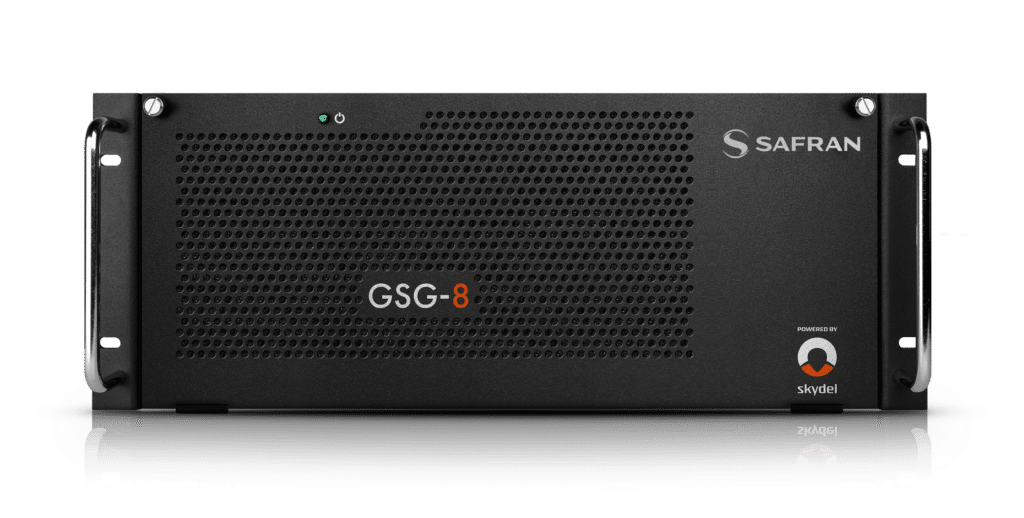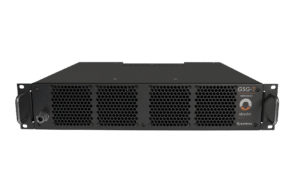Skydel GSG-8 Advanced GNSS Simulator
GNSS SIMULATION WITH UNMATCHED FLEXIBILITY
The GSG-8 GNSS Simulator is an advanced software-powered turnkey simulator, supporting multi-constellation, multi-frequency, and hundreds of satellite signals. With an incredible 1000 Hz iteration rate, the GSG-8 GPS Simulator is ideal for space trajectories, custom PNT signals, hardware-in-the-loop, and any type of all-in-view satellites simulation.
With the GSG-8 Simulator, you can generate RF signals to simulate how your receiver device will react in the real world, under the simulation parameters that you set. Control every aspect of your simulation, including 6 Degrees of Freedom (DoF) receiver trajectories, multi-vehicle simulation, multi-path signals, jamming and spoofing, as well as atmospheric interferences.
The GSG-8 is the most popular positioning, navigation, and timing test solution offered through Safran’s GSG family of Skydel-based simulators. It was developed to deliver the highest standard of Global Navigation Satellite System (GNSS) signal testing and sensor simulation performance in an easy to use, upgradable and scalable platform.
ADVANTAGES
Advanced Jamming & Spoofing
The jamming and spoofing capabilities allow you to simulate all types of interference that can occur in the real world – whether benign or malicious. You can set the power level, interference signal type, spoofing signals, location, antenna pattern and trajectory for each transmitter. You’ll be able to generate in-band and out-of-band jamming signals, with no additional hardware required.
Low Latency HIL
Low latency HIL testing is an essential step in the verification process of the Model-Based Design (MBD) approach. HIL testing is usually the last step before testing in the field and after Model-In-the-Loop (MIL), Software-In-the-Loop (SIL) or Chipset-In-the-Loop (CIL). This step is critical because it involves all the hardware and software that will be used operationally. Skydel’s low latency HIL simulation can test a standalone Device-Under-Test (DUT) or, more generally, an entire complex system consisting of multiple DUTs.
Powerful Automation
The unique and modern architecture of its Skydel Simulation engine provides an extensive API to configure and control all aspects of the simulator. The API is available in various programming languages such as Python, C#, and C++. Moreover, all human and machine interactions with the simulator can be recorded and exported as executable python script, which greatly simplifies the work of test engineers who want to automate or expand the simulator capabilities.
Custom Signals / LEO Constellations
This feature allows users to create their own custom signals and attach them to GNSS satellites so they are streamed along regular GNSS signals. This tool gives advanced users the ability to design GNSS or non-GNSS (such as LEO constellation) signals and avoid the task of designing an engine that simulates the dynamics of satellites, vehicles, and all of the associated environmental effects (atmospheric, multi-path, jamming, spoofing).
USE CASES
-
Multi-Antenna GNSS Simulation for Unmanned Aerial Vehicles (UAVs)
Safran’s Skydel GPS/GNSS Simulators enable cost-effective, scalable multi-antenna testing for UAV applications.
-
Multi-Antenna GNSS Simulation for Automotive Applications
Safran’s Skydel GPS/GNSS Simulators enable cost-effective, scalable multi-antenna testing for automotive applications.
-
GNSS Simulation for Space Launch Applications
Featuring Skydel GNSS Simulation, featuring precise orbital trajectories, realistic atmospheric models, and robust interference scenarios
CASE STUDIES
-
Safran to provide Becker Avionics with GSG-8 with fully operational SBAS function to test avionics receiver
Safran supplied a Skydel-based GSG-8 Advanced Simulator with advanced jamming and spoofing options to test the avionic receiver in real-life conditions.
-
GSG-8 and SecureSync Platforms Combined to Support GMV in the RIPTIDE Project
Discover how GMV utilized the GSG-8 and SecureSync platforms in the development of a robust PNT framework to limit the impact of GNSS vulnerabilities on maritime and inland waterways’ PNT applications within the Black Sea and Danube Lower Basin region.
-
Safran’s GSG-8 Advanced Simulator Drives R&D Testing for Stellantis (formerly FCA – Fiat Chrysler Automobiles)
Discover how the flexible and scalable GSG-8 platform delivered a cost-effective and high-end precision GNSS testing to the automotive industry.
REQUEST A QUOTE
FEATURES
- 1600+ Signals
- All-in-view satellites simulation
- 1,000 Hz iteration rate
- Low-Latency Hardware-in-the-Loop
- Ultra-High Dynamics
- User-defined waveforms
- Live Sky Time Synchronization
- On-the-fly scenario reconfiguration
- Advanced Jamming & Spoofing
- 6 degrees of freedom (DoF) receiver trajectories
- Flexible licensing
- In-field upgradeability
- Simulate hundreds of satellites in real time
- Multipath Models
- Multi-vehicle simulation
- API (Python, C#, C++)
- Scalable architecture using software-defined radios
- IQ file generation and playback
SPECS
- Size: 4U
- Weight: 39.6 lbs (18 kg)
- Width/Depth/Height: 19 in (48 cm), 16 in (40.6 cm), 7 in (18cm)
- Power Consumption: 400W
- Signals:
- GPS: L1-C/A, L1C, L1-P(Y), L2-P(Y), L2C, L5;
- NavIC L1, L5, S-Band;
- GLONASS: G1, G2;
- Galileo: E1, E5a, E5b, E6, E6PRS, E6 HAS, E5AltBOC, PRS (restricted signals), PRS-Noise, HAS-Noise; OSNMA
- BeiDou: B1, B2, B1C, B2A, B3I;
- QZSS: L1-C/A, L1 C/B, L2C, L5, L5S
- SBAS (L1/L5): WAAS, EGNOS, MSAS, GAGAN, SDCM
- Xona: PULSAR XL, X1
- Custom Signals



